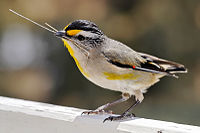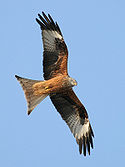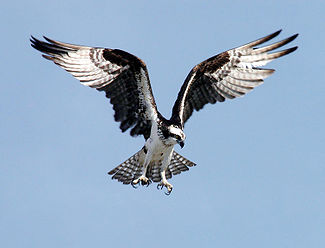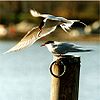- Portal:Birds
-
- Wikipedia portals:
- Culture
- Geography
- Health
- History
- Mathematics
- Natural sciences
- People
- Philosophy
- Religion
- Society
- Technology
The Birds Portal
Welcome to the Birds Portal! Birds (class Aves) are bipedal, warm-blooded, oviparous vertebrate animals. Most scientists believe that birds evolved from theropod dinosaurs. Ranging in size from tiny hummingbirds to the huge Ostrich and Emu, there are between 9,000 and 10,000 known living bird species in the world, making Aves the most diverse class of terrestrial vertebrate.A Striated Pardalote (Pardalotus striatus) collecting nesting material in its beak. A bird is characterized by feathers, a beak with no teeth, the laying of hard-shelled eggs, a high metabolic rate, a four-chambered heart, and a light but strong skeleton. Most birds have forelimbs modified as wings and can fly.
Birds are important sources of food, acquired either through farming or hunting. Numerous species of birds are also used commercially, and some species, particularly songbirds and parrots, are popular pets. Birds figure prominently in all aspects of human culture from religion to poetry and popular music. Numerous species of birds are threatened with extinction by human activities and efforts are underway to protect them.
Selected article
The term flight feather refers to any of the long, stiff, asymmetrical feathers on the wing or tail of a bird; those on the wing are called remiges (singular remex) while those on the tail are called rectrices (singular rectrix). Their primary function is to aid in the generation of both thrust and lift, thereby enabling flight. However, the flight feathers of some birds have evolved to perform additional functions, generally associated with territorial displays, courtship rituals or feeding methods. In some species, these feathers have developed into long showy plumes used in visual courtship displays, while in others they create a sound during display flights. Tiny serrations on the leading edge of their remiges help owls to fly silently (and therefore hunt more successfully), while the extra-stiff rectrices of woodpeckers help them to brace against tree trunks as they hammer. Even flightless birds still retain flight feathers, though sometimes in radically modified forms.The moult of their flight feathers can cause serious problems for birds, as it can impair their ability to fly. Different species have evolved different strategies for coping with this, ranging from dropping all their flight feathers at once (and thus becoming flightless for some relatively short period of time) to extending the moult over a period of several years.
Selected picture
The Osprey (Pandion haliaetus), also known colloquially as seahawk, fish hawk or fish eagle, is a medium-large fish-eating bird of prey or raptor. However, It is not the same as a sea-eagle. It is found on all continents except Antarctica although in South America it occurs only as a non-breeding migrant.
Topics
Birds
Anatomy: Anatomy - Skeleton - Flight - Eggs - Feathers - PlumageEvolution and extinction: Evolution - Archaeopteryx - Hybridisation - Late Quaternary prehistoric birds - Fossils - Taxonomy - Extinction
Behaviour: Singing - Intelligence - Migration - Reproduction - Nesting - Incubation - Brood parasites
Bird Orders: Struthioniformes - Tinamiformes - Anseriformes - Galliformes - Gaviiformes - Podicipediformes - Procellariiformes - Sphenisciformes - Pelecaniformes - Ciconiiformes - Phoenicopteriformes - Falconiformes - Gruiformes - Charadriiformes - Pteroclidiformes - Columbiformes - Psittaciformes - Cuculiformes - Strigiformes - Caprimulgiformes - Apodiformes - Coraciiformes - Piciformes - Trogoniformes - Coliiformes - Passeriformes
Bird lists: Families and orders - Lists by region
Birds and Humans: Ringing - Ornithology - Bird collections - Birdwatching - Birdfeeding - Conservation - Aviculture
Quotes
Resources
Free online resources:
- SORA: The Searchable Online Research Archive (SORA) has decades worth of archives of the following journals: The Auk, Condor, Journal of Field Ornithology, North American Bird Bander, Studies in Avian Biology, Pacific Coast Avifauna, and the Wilson Bulletin. Coverage ends around 2000. The ability to search all journals or browse exists on the front page.
- Notornis: The Journal of the Ornithological Society of New Zealand covers New Zealand and the South Pacific.
- New Zealand Journal of Ecology: This journal often publishes bird related articles. Like Notornis, thie journals is concerned with New Zealand and surrounding areas.
- Marine Ornithology: Published by the numerous Seabird Research Groups, Marine Ornithology is specific and goes back many years.
- BirdLife International: The Data Zone has species accounts for every species, although only threatened species have any detail beyond status and evaluation.
- Authors Names: This is a good source for binomial authorities for taxoboxes.
There is also Birds of North America, Cornell University's massive project collecting information on every Breeding bird in the ABA area. It is available for 40 USD a year.
For more sources, including printed sources, see WikiProject Birds.
Selected species
The Arctic Tern (Sterna paradisaea) is a seabird of the tern family Sternidae. This bird has a circumpolar distribution, breeding colonially in Arctic and sub-Arctic regions of Europe, Asia, and North America (as far south as Brittany and Massachusetts). The species is strongly migratory, seeing two summers each year as it migrates from its northern breeding grounds to the oceans around Antarctica and back each year. This is the longest regular migration by any known animal. Arctic Terns are medium-sized birds. They are mainly grey and white plumaged, with a red beak (as long as the head, straight, with pronounced gonys) and feet, white forehead, a black nape and crown (streaked white), and white cheeks. The Arctic Tern is K-selected, caring for and aggressively defending a small number of young. Parents feed them fish for a considerable time, and help them fly south to winter. Arctic Terns are long-lived birds, with many reaching twenty years of age. They eat mainly fish and small marine invertebrates. The species has an estimated one million individuals. Exploitation in the past has reduced this bird's numbers in the southern reaches of its range.Did you know
- ...that sexual size dimorphism in the Brown Songlark is among the most pronounced in any bird, with males as much as 2.3 times heavier than females?
- ...that Rufous Whistler birds, unlike all other Whistler birds, never forage on the ground but high up in trees or other high places?
- ...that the bill of the Magpie Duck (pictured) becomes green as the bird gets older, and its black crown may go completely white?
Categories
[×] Bird colours[×] Bird evolution[×] Bird flight[×] Images of birds[×] Bird parks[×] Bird terminologyWikiProjects
- WikiProject Birds
- WikiProject Science
- WikiProject History of Science
- WikiProject Tree of Life
- WikiProject Biology
- WikiProject Ecology
- WikiProject Extinction
Related portals
Science History of Science Biology Ecology Extinction Dinosaurs Collaboration of the month
Things you can do
Create requested articles (WikiProject Birds – Article requests):
-
-
-
- Books
- Journals
-
-
- Organisations
- People
- Places
- Species
- Spoken articles
- Other
- Attend to bird articles needing attention
Do these tasks: The current project collaboration is Jackdaw

Here are some tasks you can do:- Article requests: Ward J. M. Hagemeijer • Colin Bradshaw • Lawrence Walkinshaw • Kate Vincent (Finnish) • The Sibley Guide to Bird Life and Behavior • List of birds of Serbia (more)
- Cleanup: Parrotlet • Diving duck • Falconry (more)
- Copyedit: Gouldian Finch • Waterfowl hunting • Parrot training (more)
- Expand: List of terms used in bird topography • Nidicolous • Gouldian Finch • Cathartes • Cnemophilidae (more)
- Stubs: see Category:Bird stubs
- Verify: Canada Goose • Michel Louette • Penduline tit • Jemima Parry-Jones • Clive Byers • Ixobrychus • Journal of Ornithology • Grosbeak (more)
- Wikify: Kingston parakeets • Stephens Island Wren • Blyth's Tragopan • Cantabrian Capercaillie (more)
- Other:
Add photos to bird articles needing photos.
More outstanding tasks at Wikipedia:WikiProject Birds/Cleanup listing, Category:Birds articles needing attention, and Wikipedia:WikiProject Birds#Tasklist.
Taxonomy of Aves
Class Aves, divided into superorders, orders, suborders (where indicated), and families.
- Paleognathae
- Struthioniformes: mainly southern hemisphere; 12 species, 2 extinct
- Struthionidae: Ostrich
- Casuariidae: emus and cassowaries
- Apterygidae: kiwis
- Rheidae: rheas
- Tinamiformes: South America; 45 species
- Tinamidae: tinamous
- Struthioniformes: mainly southern hemisphere; 12 species, 2 extinct
- Neognathae
- Anseriformes: worldwide; ~150 species
- Anhimidae: screamers
- Anseranatidae: Magpie-goose
- Anatidae: swans, geese and ducks
- Galliformes: worldwide except northern Eurasia; ~250 species.
- Megapodidae: mound-builders
- Cracidae: chachalacas, guans and curassows
- Tetraonidae: grouse
- Phasianidae: partridges, pheasants, quail and allies
- Odontophoridae: New World quails
- Numididae: guineafowl
- Meleagrididae: turkeys
- Mesitornithidae: mesites
- Sphenisciformes: Antarctic and southern waters; 16 species
- Spheniscidae: penguins
- Gaviiformes: North America, Eurasia; 5 species
- Gaviidae loons or divers
- Podicipediformes: worldwide; 20 species
- Podicipedidae: grebes
- Procellariiformes: pan-oceanic; ~100 species
- Diomedeidae: albatrosses
- Procellariidae: fulmars, prions, shearwaters, gadfly and other petrels
- Pelecanoididae: diving petrels
- Hydrobatidae: storm petrels
- Pelecaniformes: worldwide; ~50 species
- Pelecanidae: pelicans
- Sulidae: gannets and boobies
- Phalacrocoracidae: cormorants
- Fregatidae: frigatebirds
- Anhingidae: Anhinga and darters
- Phaethontidae: tropicbirds
- Ciconiiformes: all continents; >100 species.
- Ardeidae: herons and bitterns
- Balaenicipitidae: Shoebill
- Scopidae: Hammerkop
- Ciconiidae: storks
- Threskiornithidae: ibises and spoonbills
- Phoenicopteridae flamingos
- Cathartidae: New World vultures and Condors, - sometimes placed in Falconiformes/Accipitriformes.
- Anseriformes: worldwide; ~150 species
-
- Falconiformes worldwide; ~260 species. Sometimes all except the falcons are separated as Accipitriformes.
- Pandionidae: Osprey
- Accipitridae: hawks, eagles, buzzards and Old World vultures, harriers, kites, and allies
- Sagittaridae: Secretary Bird
- Falconidae: falcons
- Gruiformes: worldwide; ~200 species
- Gruidae: cranes
- Aramidae: Limpkin
- Psophiidae: trumpeters
- Rallidae: rails, crakes, coots and allies
- Heliornithidae: finfoots and Sungrebe
- Rhynochetidae: Kagu
- Eurypygidae: Sunbittern
- Cariamidae: seriemas
- Otididae: bustards
- Charadriiformes: worldwide; >300 species
- Scolopacidae: typical waders or shorebirds
- Rostratulidae: painted snipe
- Jacanidae: jacanas
- Thinocoridae: seedsnipe
- Pedionomidae: Plains Wanderer
- Laridae: gulls
- Rhynchopidae: skimmers
- Sternidae: terns
- Alcidae: auks
- Stercorariidae: skuas
- Glareolidae: coursers and pratincoles
- Dromadidae: Crab Plover
- Turnicidae: buttonquails
- Burhinidae: thick-knees
- Chionididae: sheathbills
- Pluvianellidae: Magellanic Plover
- Ibidorhynchidae: Ibisbill
- Recurvirostridae: avocets and stilts
- Haematopodidae: oystercatchers
- Charadriidae: plovers and lapwings
- Pterocliformes: Africa, Europe, Asia; 16 species
- Pteroclidae: sandgrouse
- Columbiformes: worldwide; ~300 species
- Raphidae: Dodo and Rodriguez Solitaire
- Columbidae: pigeons and doves
- Psittaciformes: pan-tropical, southern temperate zones; ~330 species
- Cacatuidae: cockatoos
- Psittacidae: parrots
- Cuculiformes: worldwide; ~150 species
- Musophagidae: turacos and allies
- Cuculidae: cuckoos
- Opisthocomidae: Hoatzin
- Strigiformes: worldwide; >130 species
- Tytonidae: barn owls
- Strigidae: typical owls
- Caprimulgiformes: worldwide; ~100 species
- Steatornithidae: Oilbird
- Podargidae: frogmouths
- Nyctibiidae: potoos
- Aegothelidae: owlet-nightjars
- Caprimulgidae: nightjars
- Apodiformes: worldwide; >400 species
- Apodidae: swifts
- Hemiprocnidae: tree swifts
- Trochilidae: hummingbirds - sometimes separated as Trochiliformes
- Falconiformes worldwide; ~260 species. Sometimes all except the falcons are separated as Accipitriformes.
-
- Coliiformes: Sub-Saharan Africa; 6 species
- Coliidae: mousebirds
- Trogonidae: trogons and quetzals
- Coraciiformes: worldwide; ~200 species
- Alcedinidae: river kingfishers
- Halcyonidae: tree kingfishers
- Cerylidae: water or belted kingfishers
- Todidae: todies
- Momotidae: motmots
- Meropidae: bee-eaters
- Leptosomatidae: Cuckoo Roller
- Brachypteraciidae: ground rollers
- Coraciidae: rollers
- Upupidae: Hoopoe
- Phoeniculidae: woodhoopoes
- Bucerotidae: hornbills
- Piciformes: worldwide except Australasia; ~400 species
- Galbulidae: jacamars
- Bucconidae: puffbirds
- Capitonidae: barbets
- Indicatoridae: honeyguides
- Ramphastidae: toucans
- Picidae: woodpeckers
- Passeriformes: worldwide; >5000 species
- Suborder Tyranni ("suboscines")
- Tyrannidae: tyrant flycatchers
- Acanthisittidae: New Zealand wrens
- Pittidae: pittas
- Furnariidae: ovenbirds
- Thamnophilidae: antbirds
- Formicariidae: antpittas and antthrushes
- Conopophagidae: gnateaters
- Rhinocryptidae: tapaculos
- Cotingidae: cotingas
- Pipridae: manakins
- Philepittidae: asities
- Suborder Passeri ("oscines")
- Atrichornithidae: scrub-birds
- Menuridae: lyrebirds
- Turnagridae: Piopio
- Alaudidae: larks
- Hirundinidae: swallows
- Motacillidae: wagtails and pipits
- Campephagidae: cuckoo-shrikes
- Eupetidae: rail-babbler
- Pycnonotidae: bulbuls
- Regulidae: kinglets
- Chloropseidae: leafbirds
- Aegithinidae: ioras
- Ptilogonatidae: silky-flycatchers
- Bombycillidae: waxwings
- Hypocoliidae: hypocolius
- Dulidae: Palmchat
- Cinclidae: dippers
- Troglodytidae: wrens
- Mimidae: mockingbirds, thrashers and Gray Catbird
- Prunellidae: accentors
- Turdidae: thrushes and allies
- Cisticolidae: cisticolas and allies
- Sylviidae: Old World warblers
- Suborder Tyranni ("suboscines")
- Coliiformes: Sub-Saharan Africa; 6 species
-
-
- Polioptilidae: gnatcatchers
- Muscicapidae: Old World flycatchers
- Platysteiridae: wattle-eyes
- Petroicidae: Australasian robins
- Pachycephalidae: whistlers and allies
- Picathartidae: rockfowl
- Timaliidae: babblers
- Pomatostomidae: pseudo-babblers
- Paradoxornithidae: parrotbills
- Orthonychidae: logrunner and chowchilla
- Cinclosomatidae: whipbirds and quail-thrushes
- Aegithalidae: long-tailed tits
- Maluridae: fairy-wrens, emu-wrens and grasswrens
- Neosittidae: sitellas
- Climacteridae: Australasian treecreepers
- Paridae: chickadees and tits
- Sittidae: nuthatches
- Tichodromidae: Wallcreeper
- Certhiidae: treecreepers
- Rhabdornithidae: Philippine creepers
- Remizidae: penduline tits
- Nectariniidae: sunbirds and spiderhunters
- Melanocharitidae: berrypeckers and longbills
- Paramythiidae: tit berrypecker and crested berrypeckers
- Dicaeidae: flowerpeckers
- Pardalotidae: pardalotes, thornbills and alies
- Zosteropidae: white-eyes
- Promeropidae: sugarbirds
- Meliphagidae: honeyeaters and chats
- Oriolidae: Old World orioles
- Irenidae: fairy-bluebirds
- Laniidae: shrikes
- Malaconotidae: bushshrikes and allies
- Prionopidae: helmetshrikes
- Vangidae: vangas
- Dicruridae: drongos
- Callaeidae: wattlebirds
- Corcoracidae: White-winged Chough and Apostlebird
- Artamidae: currawongs, woodswallows, butcherbirds & allies
- Pityriaseidae: bristlehead
- Paradisaeidae: birds-of-paradise
- Ptilonorhynchidae: bowerbirds
- Corvidae: crows, jays and magpies
- Sturnidae: starlings
- Passeridae: Old World sparrows
- Ploceidae: weavers and allies
- Estrildidae: waxbills and allies
- Viduidae: indigobirds
- Vireonidae: vireos and allies
- Fringillidae: finches, crossbills and allies
- Drepanididae: Hawaiian honeycreepers
- Peucedramidae: Olive Warbler
- Parulidae: New World warblers
- Coerebidae: Bananaquit
- Thraupidae: tanagers and allies
- Emberizidae: buntings, seedeaters and allies
- Cardinalidae: saltators, cardinals and allies
- Icteridae: troupials and allies
-
Associated Wikimedia
Categories:- Birds portal
- Birds portal selected articles
- Birds portal selected pictures
- Birds portal selected quotes
- Birds portal selected species
- Birds
- Science portals
Wikimedia Foundation. 2010.






